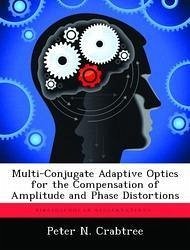Two deformable mirrors with finite conjugate ranges are investigated for compensating amplitude and phase distortions due to laser propagation through turbulent atmospheres. Simulations are performed based on Adaptive Optics (AO) for an Airborne Laser (ABL)-type scenario. The Strehl ratio, the number of branch points in deformable mirror (DM) controls, and the number of iterations to convergence are used as figures of merit to evaluate performance of the Sequential Generalized Projection Algorithm (SGPA) that generates mirror commands. The Strehl ratio and the number of branch points are plotted versus the log-amplitude variance (also known as the Rytov parameter), the conjugate range of the second deformable mirror, and the radii of the deformable mirrors. Also, the number of iterations is plotted versus the Rytov parameter and the conjugate range of the second deformable mirror. The results are ensemble averages over 32 realizations of the scintillated test fields for each value of the Rytov parameter within the test scenario. The Gaussian beam shape that optimizes the Strehl ratio is determined. The least squares two-DM Strehl, phase-only Strehl, least squares phase-only Strehl, and uncompensated Strehl are also determined for comparison.








